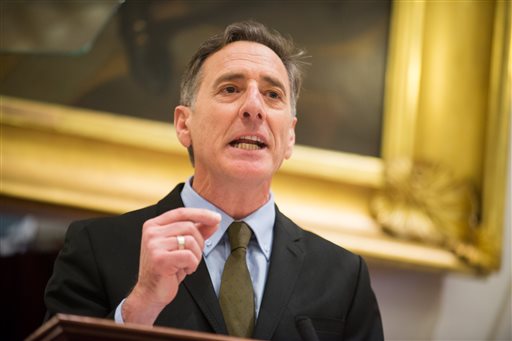(AP) Heroin and pill abuse stir a battle cry in Vermont
By WILSON RING
Associated Press
MONTPELIER, Vt.
Behind the facade of pristine ski slopes, craft beer, quaint village greens and one of the lowest unemployment rates in the country, Vermont is grappling with painkiller and heroin abuse, a challenge leaders say is fueling crime and wrecking lives and families disproportionately in this tiny state.
Nearly every day, police across Vermont are responding to burglaries or armed robberies investigators believe are prompted by the unslakable hunger for money to feed heroin or pill habits. In many cases, law enforcement officials say, what began as the abuse of prescription drugs has turned into heroin use because it’s less expensive and, more recently, easier to get.
Federal statistics rank Vermont among the top 10 states for the abuse of painkillers and illicit drug use other than marijuana _ including heroin _ for people ages 18 to 25.
Last week, Gov. Peter Shumlin took the unusual step of highlighting the challenge by devoting almost his entire State of the State address to it. He described the drug abuse as “a crisis bubbling just beneath the surface” and called on the Legislature to pass laws encouraging treatment and seek ideas on the best way to prevent people from becoming addicted in the first place. He also called for stiffer penalties for traffickers and people who use weapons in drug crimes.
The numbers are startling for a state the size of Vermont, which with 625,000 residents has a population about the same as Nashville, Tenn.:
_ It ranks second in the country for the rate of people being treated for opiate abuse, the Vermont Health Department says.
_ Over the past five years, the number of serious drug crimes rose 46 percent, according to a study released in October by the Justice Center of the Council on State Governments.
_ Last year, the number of heroin overdose deaths almost doubled from nine to 17. And the number of heroin dealers indicted at the request of Vermont’s federal prosecutors increased rose more than five times between 2010 and 2013.
_ From 2009 through 2012, the number of calls reporting suspected child abuse or neglect caused by drug abuse to the Vermont Department of Children and Families increased about 38 percent, from 3,293 to 4,555, said Commissioner Dave Yacovone.
Vermonters have no ready explanation for the rise in drug use. The state has consistently had one of the lowest unemployment rates in the country, but in his speech, Shumlin said the underlying cause of addiction was “a lack of hope and opportunity” that he proposed counteracting with good jobs and “the best early education in America.”
Many prescription painkillers belong to a class of drugs known as opioids, which also includes heroin, codeine and methadone. Many states are reporting increasing heroin problems as an unintended byproduct of efforts to crack down on painkiller abuse that didn’t include treatment of the underlying addiction, said Sherry Green, executive director of the National Alliance for Model State Drug Laws.
Shumlin wants the Legislature to expand treatment and recovery programs, and create a system that would allow some addicts to be sent for treatment immediately after their first contacts with law enforcement. He wants to emphasize treatment and search for ways to keep people from becoming addicted in the first place.
He also seeks tougher criminal penalties for drug traffickers and those who use violence during drug crimes. Shumlin, a Democrat, is proposing several million dollars in new spending to help contain the proposals. Shumlin is set to reveal a budget proposal Wednesday that could contain details on how to pay for his proposals.
While Republicans in the Vermont Legislature criticized the governor’s speech for not focusing more on jobs and the economy, they agreed with the need to fight the drug threat.
Recovering addict Dustin Machia, 25, attended Shumlin’s speech and was singled out by the governor as someone who quickly became addicted after being offered Oxycontin, a powerful opioid, in high school.
He soon became a $500-a-day addict who stole $20,000 worth of equipment from the family farm before his mother introduced him to a local physician who helped him. It took him more than a week to get into a rehabilitation program.
Machia, who lives in the community of Swanton, just a few miles from the Quebec border, managed to overcome his addiction with the help of family, friends and hard work. He said his experience came before heroin reared its head in Vermont and he also hopes the Legislature can find ways to get people the help they need when they ask for it.
The demand for heroin is being quickly filled by out-of-state drug dealers or Vermonters who travel to cities in southern New England or beyond, where heroin can cost $5 to $10 per bag. A couple of years ago they were being sold in Vermont for $40, but now they fetch $15 to $20, said Maj. Glenn Hall, head of the Vermont State Police’s criminal division.
Vermont’s public health community is responding. Since 2008, the state has funded 11 recovery centers. But the governor says more can be done.

COMMENTS
Please let us know if you're having issues with commenting.